Dissertation: IT Lead Generation Process Analysis and Survey Results
VerifiedAdded on 2022/10/02
|52
|14935
|273
Thesis and Dissertation
AI Summary
This dissertation presents the methodology, data analysis, and findings of a market research survey focused on lead generation within the IT industry. The study investigates various lead generation methods, including email marketing, content marketing, digital advertising, and LinkedIn-based marketing, assessing their usage and effectiveness. The research employs a quantitative approach, utilizing a survey distributed to professionals in the IT sector, including CEOs, marketing managers, and business development managers. The methodology section outlines the research philosophy (positivist), approach (quantitative deductive), design (descriptive), and strategy (quantitative survey), along with sampling techniques and data collection procedures. The data analysis chapter includes descriptive and inferential statistics, such as correlation and regression analysis, to identify relationships between variables and test hypotheses. The findings reveal the most commonly used and effective lead generation methods, as well as insights into the respondents' perceptions of lead generation strategies. The dissertation concludes with implications for theory, policy, and practice, offering recommendations for private and public sector managers to optimize their marketing efforts. Limitations of the study and suggestions for further research are also provided.
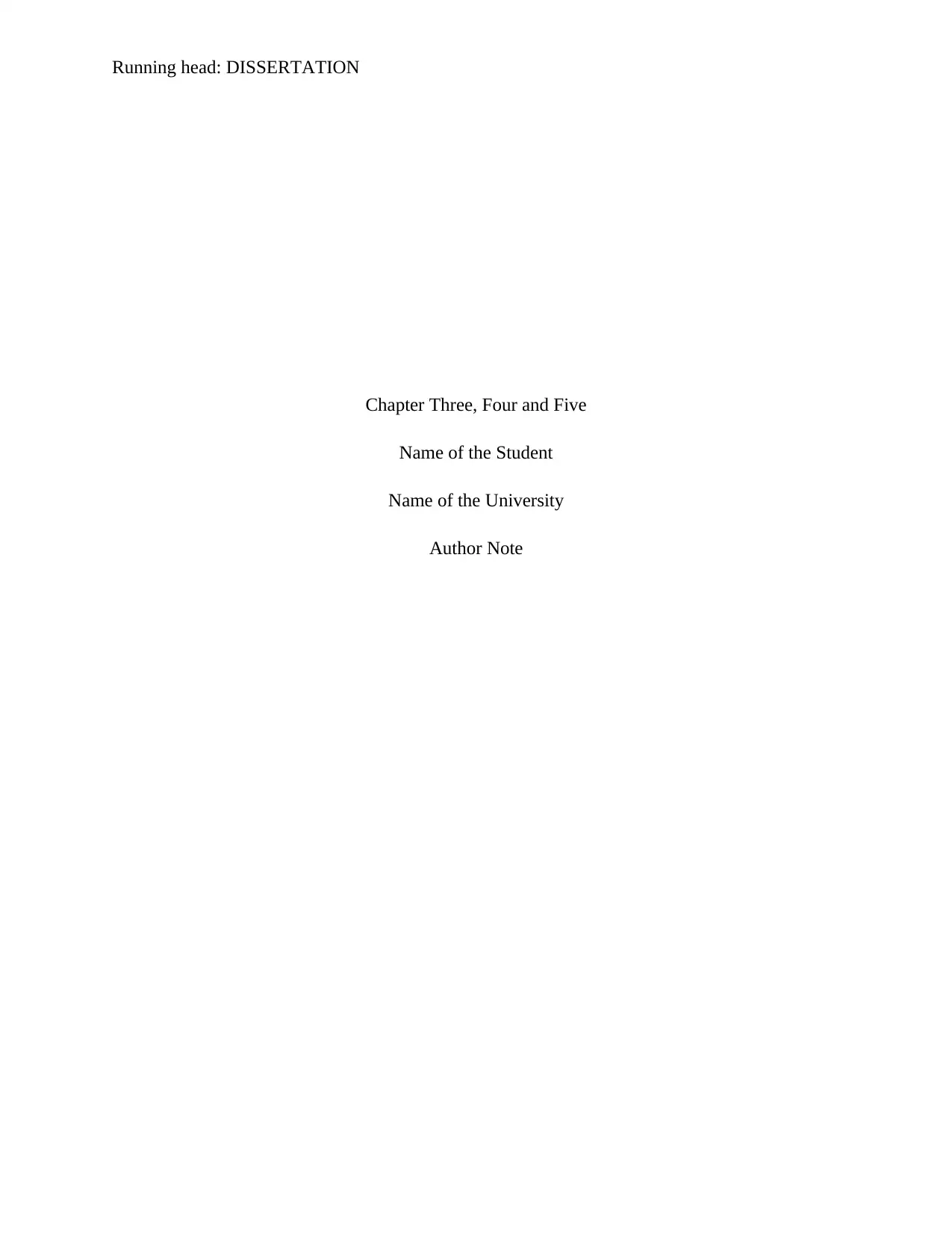
Running head: DISSERTATION
Chapter Three, Four and Five
Name of the Student
Name of the University
Author Note
Chapter Three, Four and Five
Name of the Student
Name of the University
Author Note
Paraphrase This Document
Need a fresh take? Get an instant paraphrase of this document with our AI Paraphraser
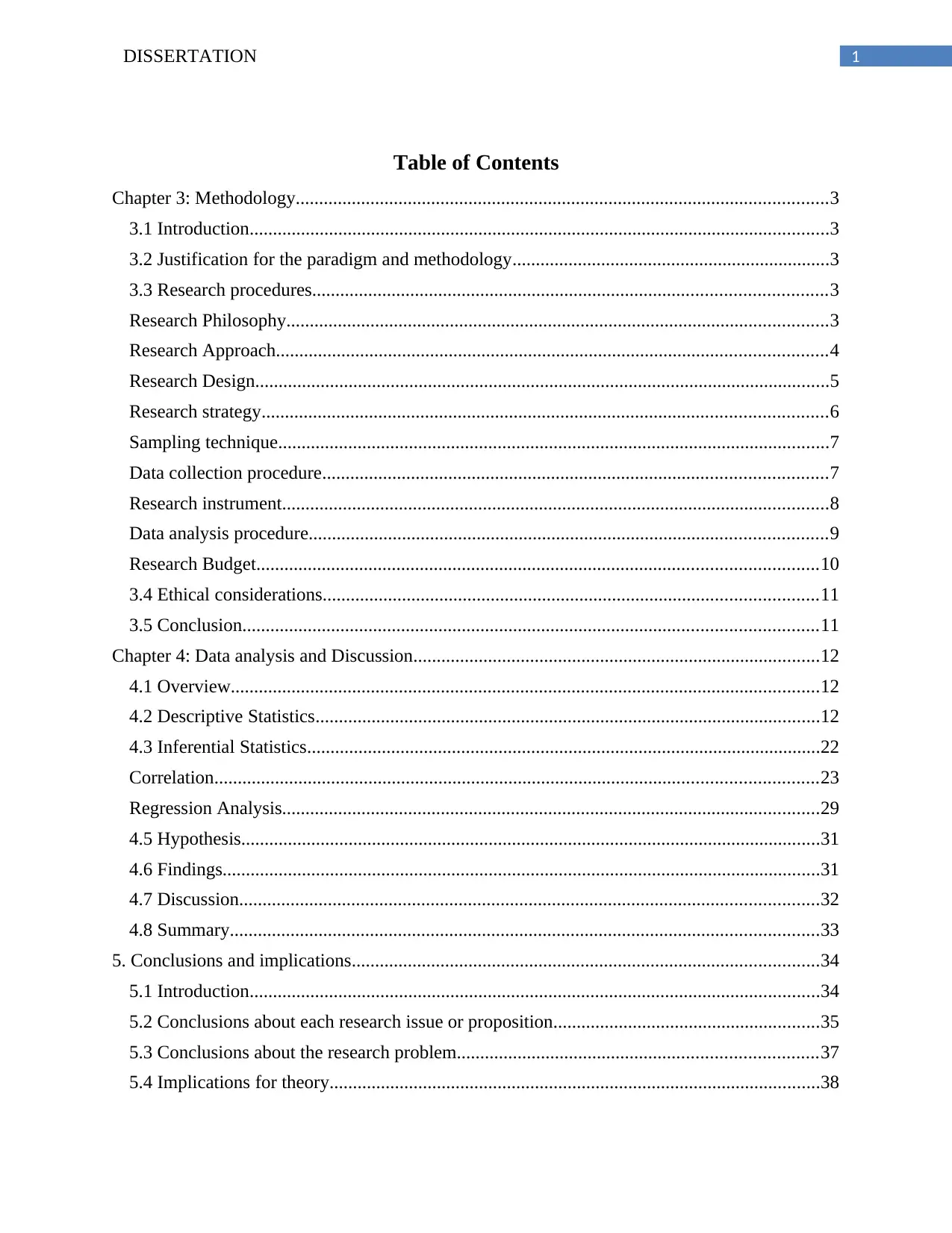
1DISSERTATION
Table of Contents
Chapter 3: Methodology..................................................................................................................3
3.1 Introduction............................................................................................................................3
3.2 Justification for the paradigm and methodology....................................................................3
3.3 Research procedures..............................................................................................................3
Research Philosophy....................................................................................................................3
Research Approach......................................................................................................................4
Research Design...........................................................................................................................5
Research strategy.........................................................................................................................6
Sampling technique......................................................................................................................7
Data collection procedure............................................................................................................7
Research instrument.....................................................................................................................8
Data analysis procedure...............................................................................................................9
Research Budget........................................................................................................................10
3.4 Ethical considerations..........................................................................................................11
3.5 Conclusion...........................................................................................................................11
Chapter 4: Data analysis and Discussion.......................................................................................12
4.1 Overview..............................................................................................................................12
4.2 Descriptive Statistics............................................................................................................12
4.3 Inferential Statistics..............................................................................................................22
Correlation.................................................................................................................................23
Regression Analysis...................................................................................................................29
4.5 Hypothesis............................................................................................................................31
4.6 Findings................................................................................................................................31
4.7 Discussion............................................................................................................................32
4.8 Summary..............................................................................................................................33
5. Conclusions and implications....................................................................................................34
5.1 Introduction..........................................................................................................................34
5.2 Conclusions about each research issue or proposition.........................................................35
5.3 Conclusions about the research problem.............................................................................37
5.4 Implications for theory.........................................................................................................38
Table of Contents
Chapter 3: Methodology..................................................................................................................3
3.1 Introduction............................................................................................................................3
3.2 Justification for the paradigm and methodology....................................................................3
3.3 Research procedures..............................................................................................................3
Research Philosophy....................................................................................................................3
Research Approach......................................................................................................................4
Research Design...........................................................................................................................5
Research strategy.........................................................................................................................6
Sampling technique......................................................................................................................7
Data collection procedure............................................................................................................7
Research instrument.....................................................................................................................8
Data analysis procedure...............................................................................................................9
Research Budget........................................................................................................................10
3.4 Ethical considerations..........................................................................................................11
3.5 Conclusion...........................................................................................................................11
Chapter 4: Data analysis and Discussion.......................................................................................12
4.1 Overview..............................................................................................................................12
4.2 Descriptive Statistics............................................................................................................12
4.3 Inferential Statistics..............................................................................................................22
Correlation.................................................................................................................................23
Regression Analysis...................................................................................................................29
4.5 Hypothesis............................................................................................................................31
4.6 Findings................................................................................................................................31
4.7 Discussion............................................................................................................................32
4.8 Summary..............................................................................................................................33
5. Conclusions and implications....................................................................................................34
5.1 Introduction..........................................................................................................................34
5.2 Conclusions about each research issue or proposition.........................................................35
5.3 Conclusions about the research problem.............................................................................37
5.4 Implications for theory.........................................................................................................38
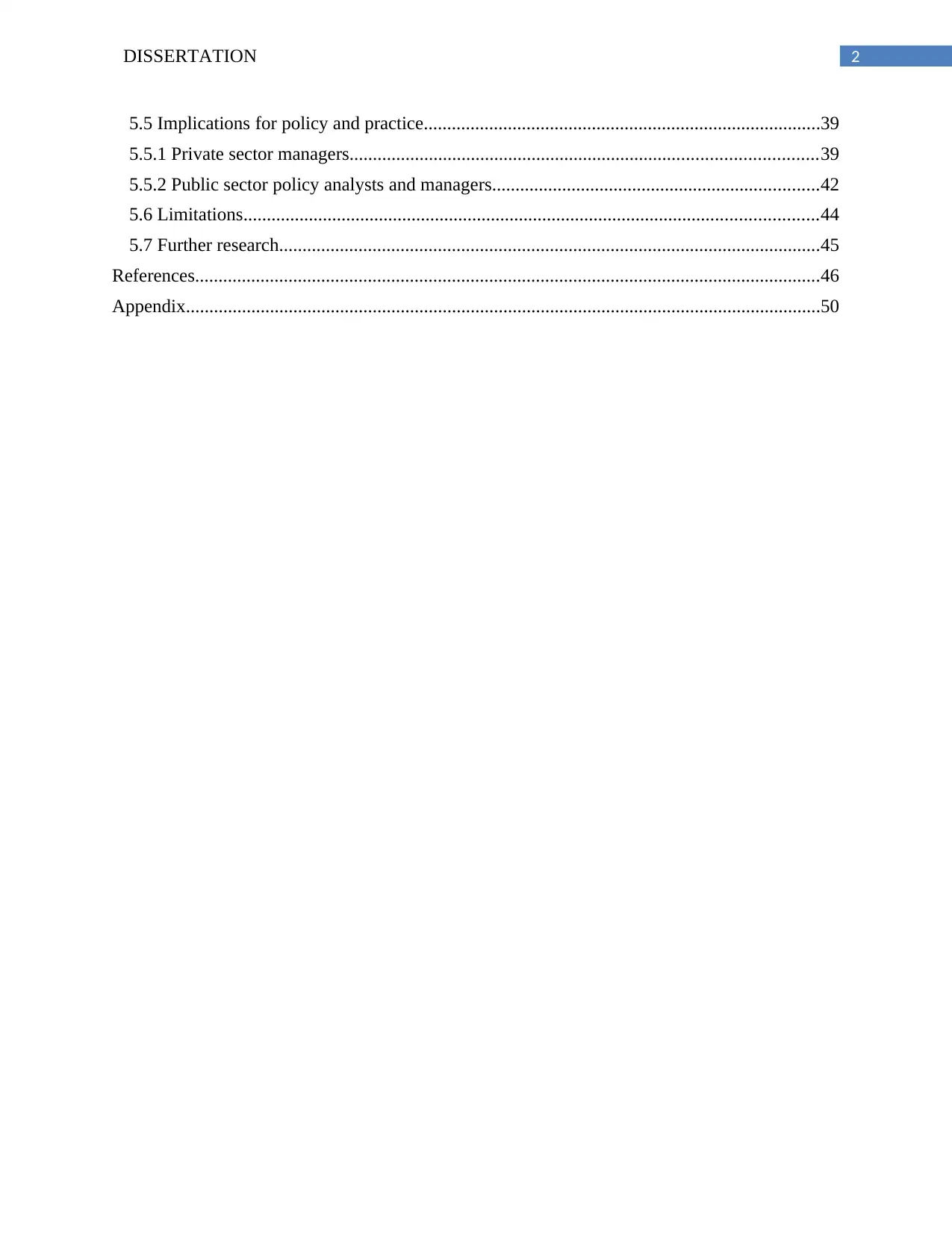
2DISSERTATION
5.5 Implications for policy and practice.....................................................................................39
5.5.1 Private sector managers....................................................................................................39
5.5.2 Public sector policy analysts and managers......................................................................42
5.6 Limitations...........................................................................................................................44
5.7 Further research....................................................................................................................45
References......................................................................................................................................46
Appendix........................................................................................................................................50
5.5 Implications for policy and practice.....................................................................................39
5.5.1 Private sector managers....................................................................................................39
5.5.2 Public sector policy analysts and managers......................................................................42
5.6 Limitations...........................................................................................................................44
5.7 Further research....................................................................................................................45
References......................................................................................................................................46
Appendix........................................................................................................................................50
⊘ This is a preview!⊘
Do you want full access?
Subscribe today to unlock all pages.

Trusted by 1+ million students worldwide
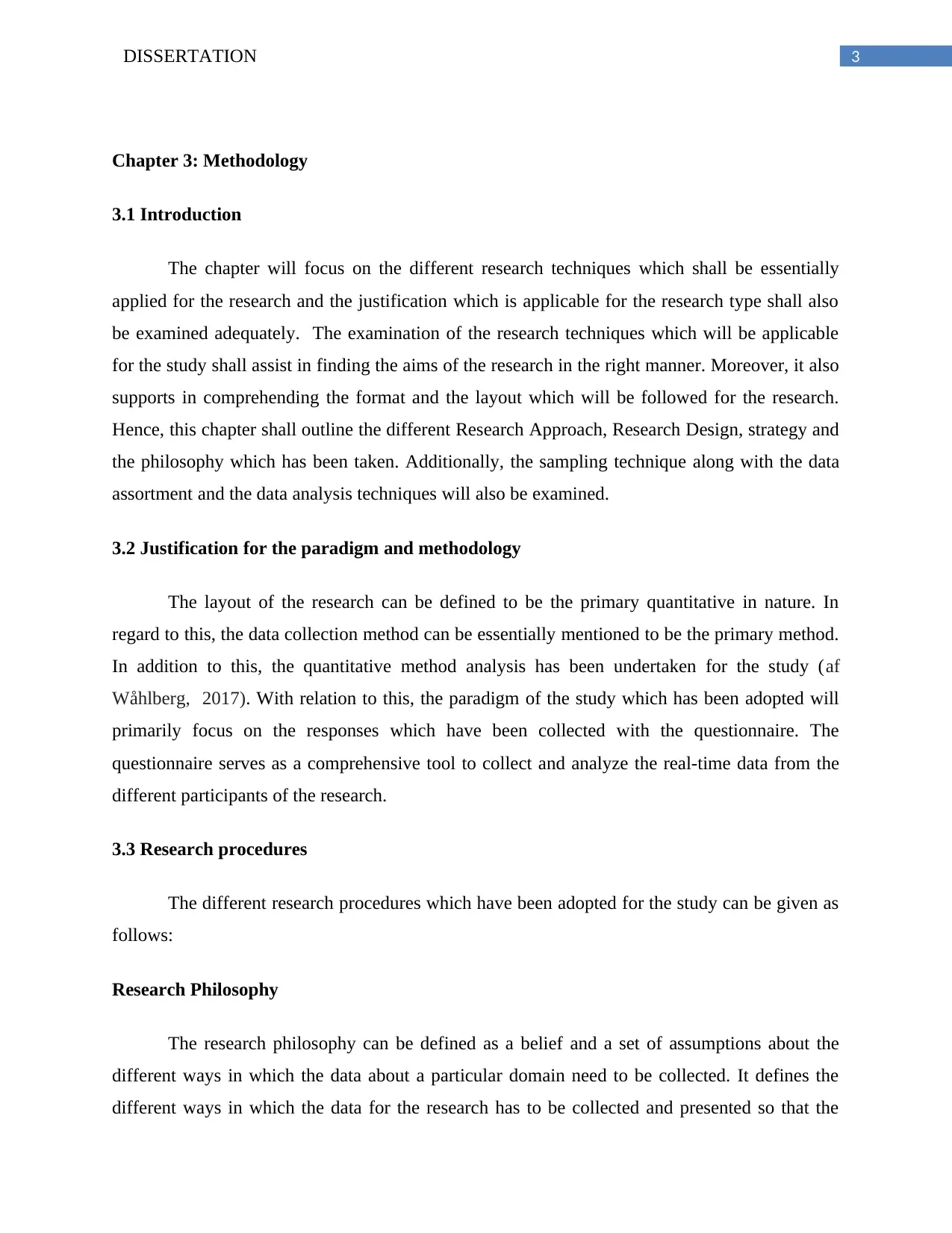
3DISSERTATION
Chapter 3: Methodology
3.1 Introduction
The chapter will focus on the different research techniques which shall be essentially
applied for the research and the justification which is applicable for the research type shall also
be examined adequately. The examination of the research techniques which will be applicable
for the study shall assist in finding the aims of the research in the right manner. Moreover, it also
supports in comprehending the format and the layout which will be followed for the research.
Hence, this chapter shall outline the different Research Approach, Research Design, strategy and
the philosophy which has been taken. Additionally, the sampling technique along with the data
assortment and the data analysis techniques will also be examined.
3.2 Justification for the paradigm and methodology
The layout of the research can be defined to be the primary quantitative in nature. In
regard to this, the data collection method can be essentially mentioned to be the primary method.
In addition to this, the quantitative method analysis has been undertaken for the study (af
Wåhlberg, 2017). With relation to this, the paradigm of the study which has been adopted will
primarily focus on the responses which have been collected with the questionnaire. The
questionnaire serves as a comprehensive tool to collect and analyze the real-time data from the
different participants of the research.
3.3 Research procedures
The different research procedures which have been adopted for the study can be given as
follows:
Research Philosophy
The research philosophy can be defined as a belief and a set of assumptions about the
different ways in which the data about a particular domain need to be collected. It defines the
different ways in which the data for the research has to be collected and presented so that the
Chapter 3: Methodology
3.1 Introduction
The chapter will focus on the different research techniques which shall be essentially
applied for the research and the justification which is applicable for the research type shall also
be examined adequately. The examination of the research techniques which will be applicable
for the study shall assist in finding the aims of the research in the right manner. Moreover, it also
supports in comprehending the format and the layout which will be followed for the research.
Hence, this chapter shall outline the different Research Approach, Research Design, strategy and
the philosophy which has been taken. Additionally, the sampling technique along with the data
assortment and the data analysis techniques will also be examined.
3.2 Justification for the paradigm and methodology
The layout of the research can be defined to be the primary quantitative in nature. In
regard to this, the data collection method can be essentially mentioned to be the primary method.
In addition to this, the quantitative method analysis has been undertaken for the study (af
Wåhlberg, 2017). With relation to this, the paradigm of the study which has been adopted will
primarily focus on the responses which have been collected with the questionnaire. The
questionnaire serves as a comprehensive tool to collect and analyze the real-time data from the
different participants of the research.
3.3 Research procedures
The different research procedures which have been adopted for the study can be given as
follows:
Research Philosophy
The research philosophy can be defined as a belief and a set of assumptions about the
different ways in which the data about a particular domain need to be collected. It defines the
different ways in which the data for the research has to be collected and presented so that the
Paraphrase This Document
Need a fresh take? Get an instant paraphrase of this document with our AI Paraphraser
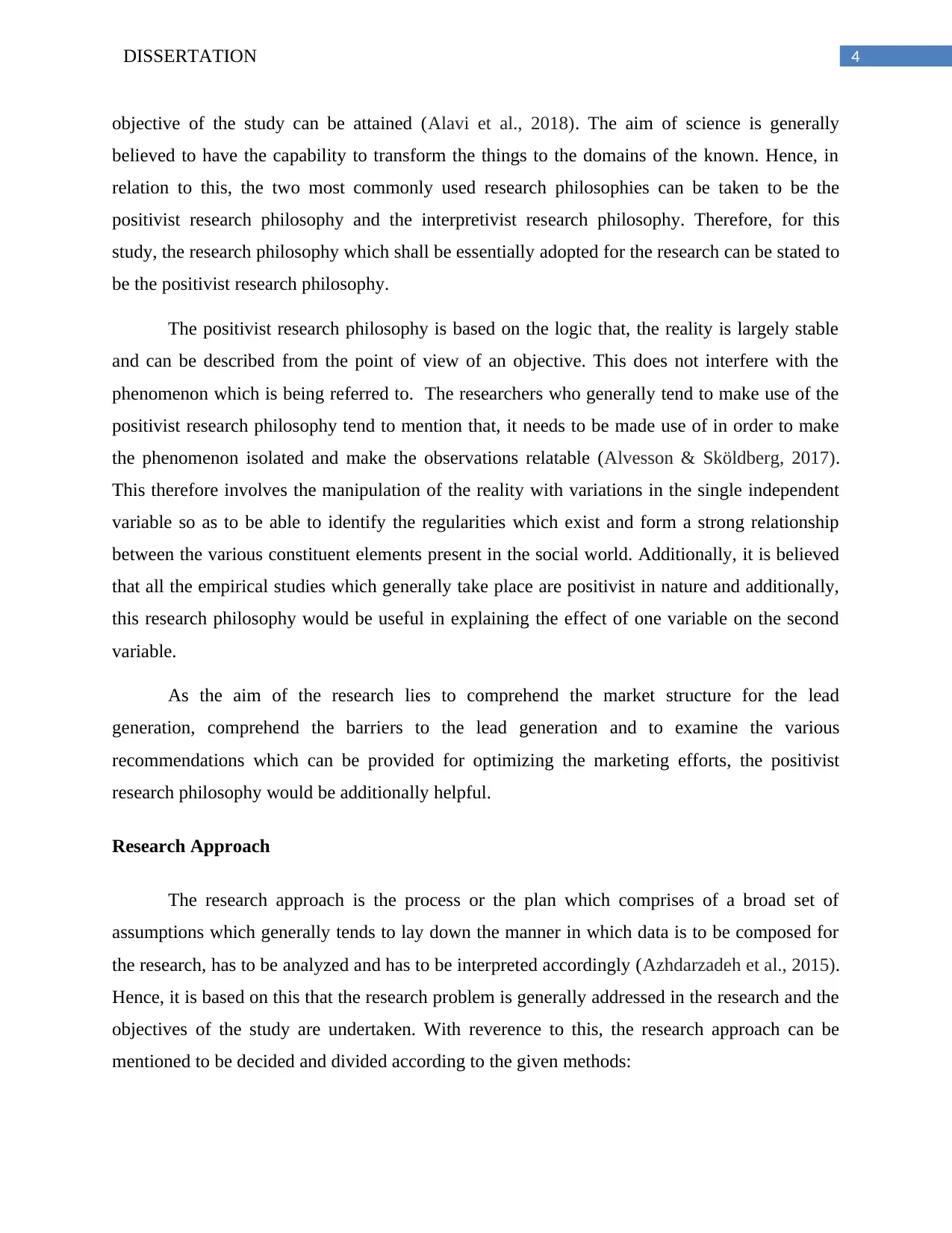
4DISSERTATION
objective of the study can be attained (Alavi et al., 2018). The aim of science is generally
believed to have the capability to transform the things to the domains of the known. Hence, in
relation to this, the two most commonly used research philosophies can be taken to be the
positivist research philosophy and the interpretivist research philosophy. Therefore, for this
study, the research philosophy which shall be essentially adopted for the research can be stated to
be the positivist research philosophy.
The positivist research philosophy is based on the logic that, the reality is largely stable
and can be described from the point of view of an objective. This does not interfere with the
phenomenon which is being referred to. The researchers who generally tend to make use of the
positivist research philosophy tend to mention that, it needs to be made use of in order to make
the phenomenon isolated and make the observations relatable (Alvesson & Sköldberg, 2017).
This therefore involves the manipulation of the reality with variations in the single independent
variable so as to be able to identify the regularities which exist and form a strong relationship
between the various constituent elements present in the social world. Additionally, it is believed
that all the empirical studies which generally take place are positivist in nature and additionally,
this research philosophy would be useful in explaining the effect of one variable on the second
variable.
As the aim of the research lies to comprehend the market structure for the lead
generation, comprehend the barriers to the lead generation and to examine the various
recommendations which can be provided for optimizing the marketing efforts, the positivist
research philosophy would be additionally helpful.
Research Approach
The research approach is the process or the plan which comprises of a broad set of
assumptions which generally tends to lay down the manner in which data is to be composed for
the research, has to be analyzed and has to be interpreted accordingly (Azhdarzadeh et al., 2015).
Hence, it is based on this that the research problem is generally addressed in the research and the
objectives of the study are undertaken. With reverence to this, the research approach can be
mentioned to be decided and divided according to the given methods:
objective of the study can be attained (Alavi et al., 2018). The aim of science is generally
believed to have the capability to transform the things to the domains of the known. Hence, in
relation to this, the two most commonly used research philosophies can be taken to be the
positivist research philosophy and the interpretivist research philosophy. Therefore, for this
study, the research philosophy which shall be essentially adopted for the research can be stated to
be the positivist research philosophy.
The positivist research philosophy is based on the logic that, the reality is largely stable
and can be described from the point of view of an objective. This does not interfere with the
phenomenon which is being referred to. The researchers who generally tend to make use of the
positivist research philosophy tend to mention that, it needs to be made use of in order to make
the phenomenon isolated and make the observations relatable (Alvesson & Sköldberg, 2017).
This therefore involves the manipulation of the reality with variations in the single independent
variable so as to be able to identify the regularities which exist and form a strong relationship
between the various constituent elements present in the social world. Additionally, it is believed
that all the empirical studies which generally take place are positivist in nature and additionally,
this research philosophy would be useful in explaining the effect of one variable on the second
variable.
As the aim of the research lies to comprehend the market structure for the lead
generation, comprehend the barriers to the lead generation and to examine the various
recommendations which can be provided for optimizing the marketing efforts, the positivist
research philosophy would be additionally helpful.
Research Approach
The research approach is the process or the plan which comprises of a broad set of
assumptions which generally tends to lay down the manner in which data is to be composed for
the research, has to be analyzed and has to be interpreted accordingly (Azhdarzadeh et al., 2015).
Hence, it is based on this that the research problem is generally addressed in the research and the
objectives of the study are undertaken. With reverence to this, the research approach can be
mentioned to be decided and divided according to the given methods:
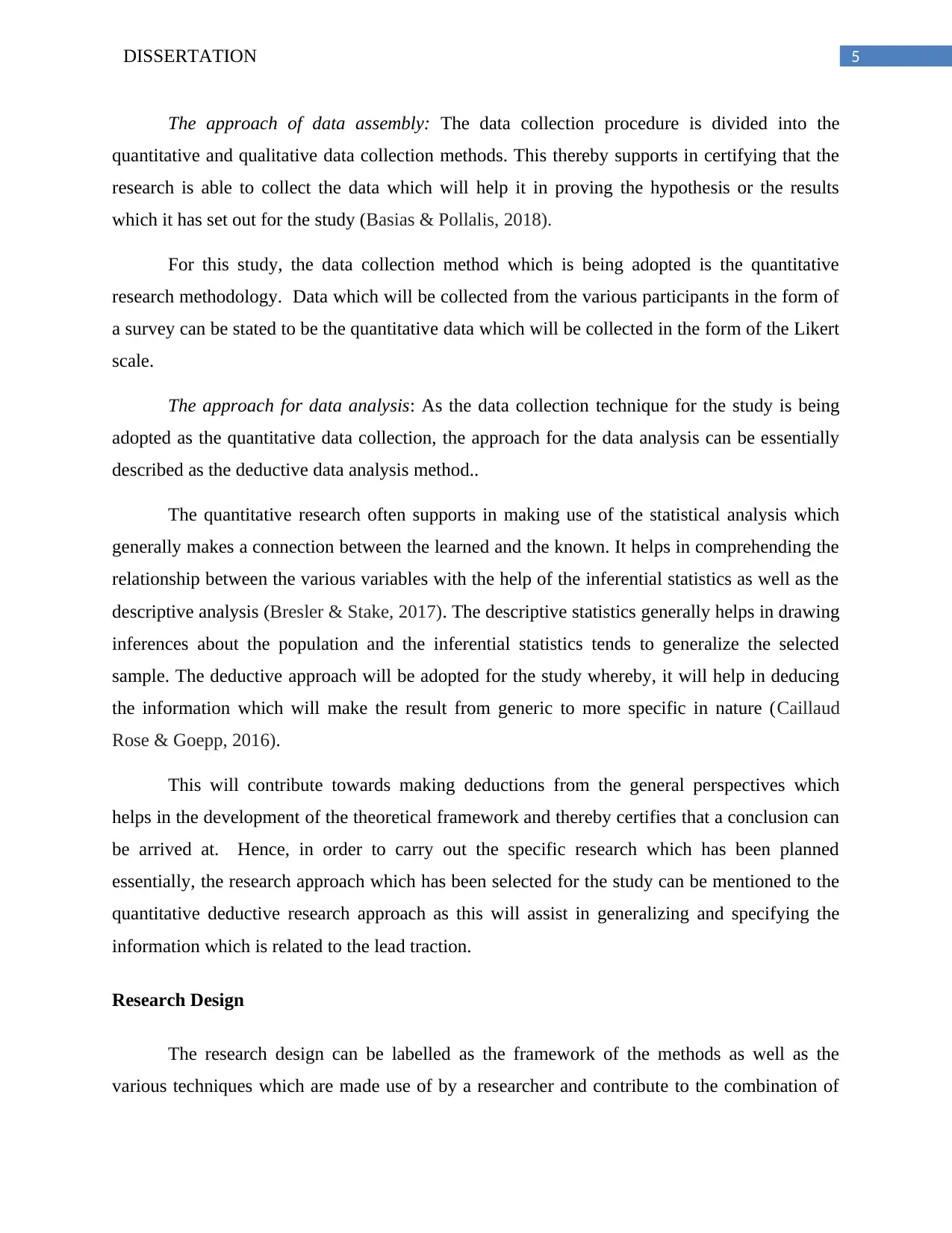
5DISSERTATION
The approach of data assembly: The data collection procedure is divided into the
quantitative and qualitative data collection methods. This thereby supports in certifying that the
research is able to collect the data which will help it in proving the hypothesis or the results
which it has set out for the study (Basias & Pollalis, 2018).
For this study, the data collection method which is being adopted is the quantitative
research methodology. Data which will be collected from the various participants in the form of
a survey can be stated to be the quantitative data which will be collected in the form of the Likert
scale.
The approach for data analysis: As the data collection technique for the study is being
adopted as the quantitative data collection, the approach for the data analysis can be essentially
described as the deductive data analysis method..
The quantitative research often supports in making use of the statistical analysis which
generally makes a connection between the learned and the known. It helps in comprehending the
relationship between the various variables with the help of the inferential statistics as well as the
descriptive analysis (Bresler & Stake, 2017). The descriptive statistics generally helps in drawing
inferences about the population and the inferential statistics tends to generalize the selected
sample. The deductive approach will be adopted for the study whereby, it will help in deducing
the information which will make the result from generic to more specific in nature (Caillaud
Rose & Goepp, 2016).
This will contribute towards making deductions from the general perspectives which
helps in the development of the theoretical framework and thereby certifies that a conclusion can
be arrived at. Hence, in order to carry out the specific research which has been planned
essentially, the research approach which has been selected for the study can be mentioned to the
quantitative deductive research approach as this will assist in generalizing and specifying the
information which is related to the lead traction.
Research Design
The research design can be labelled as the framework of the methods as well as the
various techniques which are made use of by a researcher and contribute to the combination of
The approach of data assembly: The data collection procedure is divided into the
quantitative and qualitative data collection methods. This thereby supports in certifying that the
research is able to collect the data which will help it in proving the hypothesis or the results
which it has set out for the study (Basias & Pollalis, 2018).
For this study, the data collection method which is being adopted is the quantitative
research methodology. Data which will be collected from the various participants in the form of
a survey can be stated to be the quantitative data which will be collected in the form of the Likert
scale.
The approach for data analysis: As the data collection technique for the study is being
adopted as the quantitative data collection, the approach for the data analysis can be essentially
described as the deductive data analysis method..
The quantitative research often supports in making use of the statistical analysis which
generally makes a connection between the learned and the known. It helps in comprehending the
relationship between the various variables with the help of the inferential statistics as well as the
descriptive analysis (Bresler & Stake, 2017). The descriptive statistics generally helps in drawing
inferences about the population and the inferential statistics tends to generalize the selected
sample. The deductive approach will be adopted for the study whereby, it will help in deducing
the information which will make the result from generic to more specific in nature (Caillaud
Rose & Goepp, 2016).
This will contribute towards making deductions from the general perspectives which
helps in the development of the theoretical framework and thereby certifies that a conclusion can
be arrived at. Hence, in order to carry out the specific research which has been planned
essentially, the research approach which has been selected for the study can be mentioned to the
quantitative deductive research approach as this will assist in generalizing and specifying the
information which is related to the lead traction.
Research Design
The research design can be labelled as the framework of the methods as well as the
various techniques which are made use of by a researcher and contribute to the combination of
⊘ This is a preview!⊘
Do you want full access?
Subscribe today to unlock all pages.

Trusted by 1+ million students worldwide
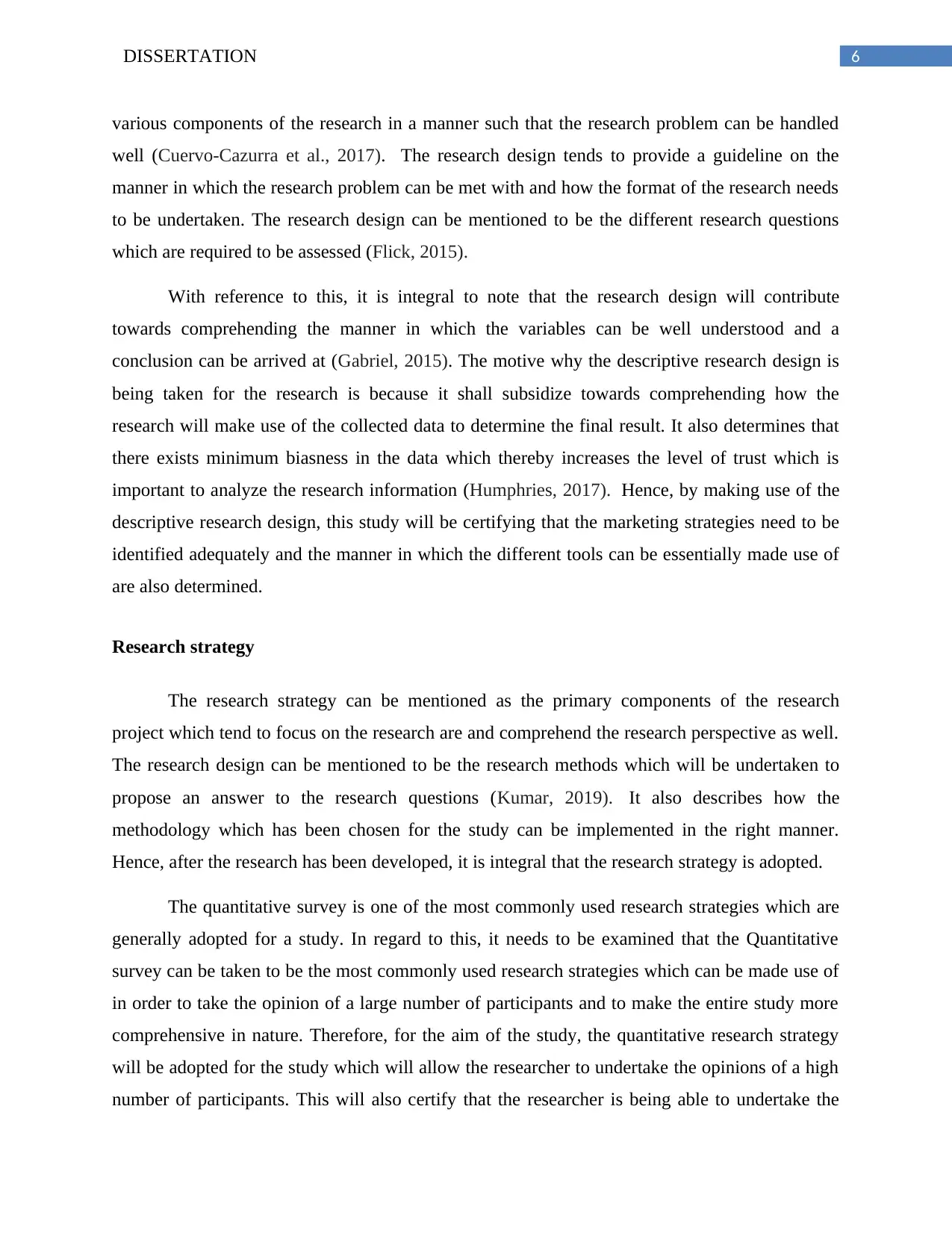
6DISSERTATION
various components of the research in a manner such that the research problem can be handled
well (Cuervo‐Cazurra et al., 2017). The research design tends to provide a guideline on the
manner in which the research problem can be met with and how the format of the research needs
to be undertaken. The research design can be mentioned to be the different research questions
which are required to be assessed (Flick, 2015).
With reference to this, it is integral to note that the research design will contribute
towards comprehending the manner in which the variables can be well understood and a
conclusion can be arrived at (Gabriel, 2015). The motive why the descriptive research design is
being taken for the research is because it shall subsidize towards comprehending how the
research will make use of the collected data to determine the final result. It also determines that
there exists minimum biasness in the data which thereby increases the level of trust which is
important to analyze the research information (Humphries, 2017). Hence, by making use of the
descriptive research design, this study will be certifying that the marketing strategies need to be
identified adequately and the manner in which the different tools can be essentially made use of
are also determined.
Research strategy
The research strategy can be mentioned as the primary components of the research
project which tend to focus on the research are and comprehend the research perspective as well.
The research design can be mentioned to be the research methods which will be undertaken to
propose an answer to the research questions (Kumar, 2019). It also describes how the
methodology which has been chosen for the study can be implemented in the right manner.
Hence, after the research has been developed, it is integral that the research strategy is adopted.
The quantitative survey is one of the most commonly used research strategies which are
generally adopted for a study. In regard to this, it needs to be examined that the Quantitative
survey can be taken to be the most commonly used research strategies which can be made use of
in order to take the opinion of a large number of participants and to make the entire study more
comprehensive in nature. Therefore, for the aim of the study, the quantitative research strategy
will be adopted for the study which will allow the researcher to undertake the opinions of a high
number of participants. This will also certify that the researcher is being able to undertake the
various components of the research in a manner such that the research problem can be handled
well (Cuervo‐Cazurra et al., 2017). The research design tends to provide a guideline on the
manner in which the research problem can be met with and how the format of the research needs
to be undertaken. The research design can be mentioned to be the different research questions
which are required to be assessed (Flick, 2015).
With reference to this, it is integral to note that the research design will contribute
towards comprehending the manner in which the variables can be well understood and a
conclusion can be arrived at (Gabriel, 2015). The motive why the descriptive research design is
being taken for the research is because it shall subsidize towards comprehending how the
research will make use of the collected data to determine the final result. It also determines that
there exists minimum biasness in the data which thereby increases the level of trust which is
important to analyze the research information (Humphries, 2017). Hence, by making use of the
descriptive research design, this study will be certifying that the marketing strategies need to be
identified adequately and the manner in which the different tools can be essentially made use of
are also determined.
Research strategy
The research strategy can be mentioned as the primary components of the research
project which tend to focus on the research are and comprehend the research perspective as well.
The research design can be mentioned to be the research methods which will be undertaken to
propose an answer to the research questions (Kumar, 2019). It also describes how the
methodology which has been chosen for the study can be implemented in the right manner.
Hence, after the research has been developed, it is integral that the research strategy is adopted.
The quantitative survey is one of the most commonly used research strategies which are
generally adopted for a study. In regard to this, it needs to be examined that the Quantitative
survey can be taken to be the most commonly used research strategies which can be made use of
in order to take the opinion of a large number of participants and to make the entire study more
comprehensive in nature. Therefore, for the aim of the study, the quantitative research strategy
will be adopted for the study which will allow the researcher to undertake the opinions of a high
number of participants. This will also certify that the researcher is being able to undertake the
Paraphrase This Document
Need a fresh take? Get an instant paraphrase of this document with our AI Paraphraser
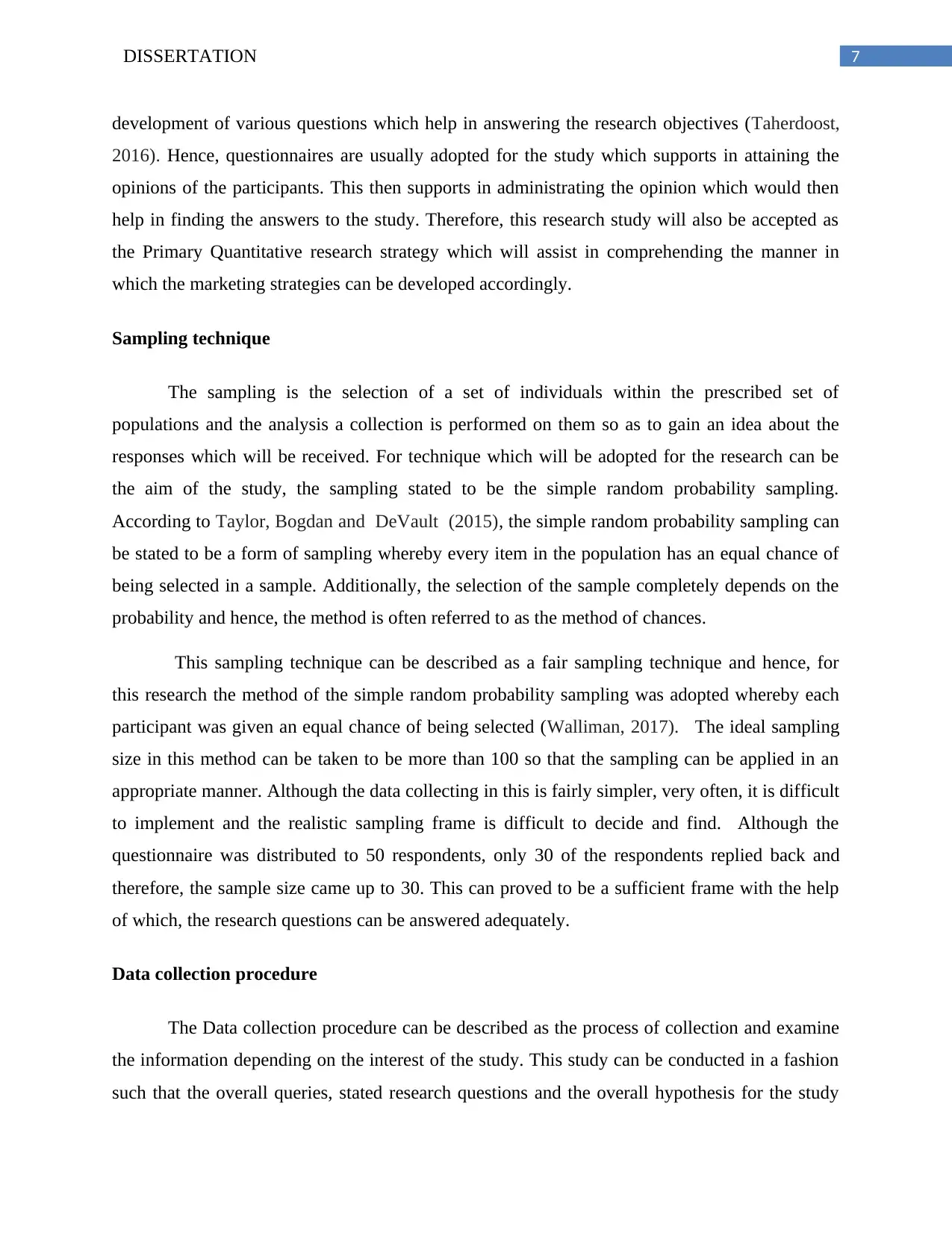
7DISSERTATION
development of various questions which help in answering the research objectives (Taherdoost,
2016). Hence, questionnaires are usually adopted for the study which supports in attaining the
opinions of the participants. This then supports in administrating the opinion which would then
help in finding the answers to the study. Therefore, this research study will also be accepted as
the Primary Quantitative research strategy which will assist in comprehending the manner in
which the marketing strategies can be developed accordingly.
Sampling technique
The sampling is the selection of a set of individuals within the prescribed set of
populations and the analysis a collection is performed on them so as to gain an idea about the
responses which will be received. For technique which will be adopted for the research can be
the aim of the study, the sampling stated to be the simple random probability sampling.
According to Taylor, Bogdan and DeVault (2015), the simple random probability sampling can
be stated to be a form of sampling whereby every item in the population has an equal chance of
being selected in a sample. Additionally, the selection of the sample completely depends on the
probability and hence, the method is often referred to as the method of chances.
This sampling technique can be described as a fair sampling technique and hence, for
this research the method of the simple random probability sampling was adopted whereby each
participant was given an equal chance of being selected (Walliman, 2017). The ideal sampling
size in this method can be taken to be more than 100 so that the sampling can be applied in an
appropriate manner. Although the data collecting in this is fairly simpler, very often, it is difficult
to implement and the realistic sampling frame is difficult to decide and find. Although the
questionnaire was distributed to 50 respondents, only 30 of the respondents replied back and
therefore, the sample size came up to 30. This can proved to be a sufficient frame with the help
of which, the research questions can be answered adequately.
Data collection procedure
The Data collection procedure can be described as the process of collection and examine
the information depending on the interest of the study. This study can be conducted in a fashion
such that the overall queries, stated research questions and the overall hypothesis for the study
development of various questions which help in answering the research objectives (Taherdoost,
2016). Hence, questionnaires are usually adopted for the study which supports in attaining the
opinions of the participants. This then supports in administrating the opinion which would then
help in finding the answers to the study. Therefore, this research study will also be accepted as
the Primary Quantitative research strategy which will assist in comprehending the manner in
which the marketing strategies can be developed accordingly.
Sampling technique
The sampling is the selection of a set of individuals within the prescribed set of
populations and the analysis a collection is performed on them so as to gain an idea about the
responses which will be received. For technique which will be adopted for the research can be
the aim of the study, the sampling stated to be the simple random probability sampling.
According to Taylor, Bogdan and DeVault (2015), the simple random probability sampling can
be stated to be a form of sampling whereby every item in the population has an equal chance of
being selected in a sample. Additionally, the selection of the sample completely depends on the
probability and hence, the method is often referred to as the method of chances.
This sampling technique can be described as a fair sampling technique and hence, for
this research the method of the simple random probability sampling was adopted whereby each
participant was given an equal chance of being selected (Walliman, 2017). The ideal sampling
size in this method can be taken to be more than 100 so that the sampling can be applied in an
appropriate manner. Although the data collecting in this is fairly simpler, very often, it is difficult
to implement and the realistic sampling frame is difficult to decide and find. Although the
questionnaire was distributed to 50 respondents, only 30 of the respondents replied back and
therefore, the sample size came up to 30. This can proved to be a sufficient frame with the help
of which, the research questions can be answered adequately.
Data collection procedure
The Data collection procedure can be described as the process of collection and examine
the information depending on the interest of the study. This study can be conducted in a fashion
such that the overall queries, stated research questions and the overall hypothesis for the study
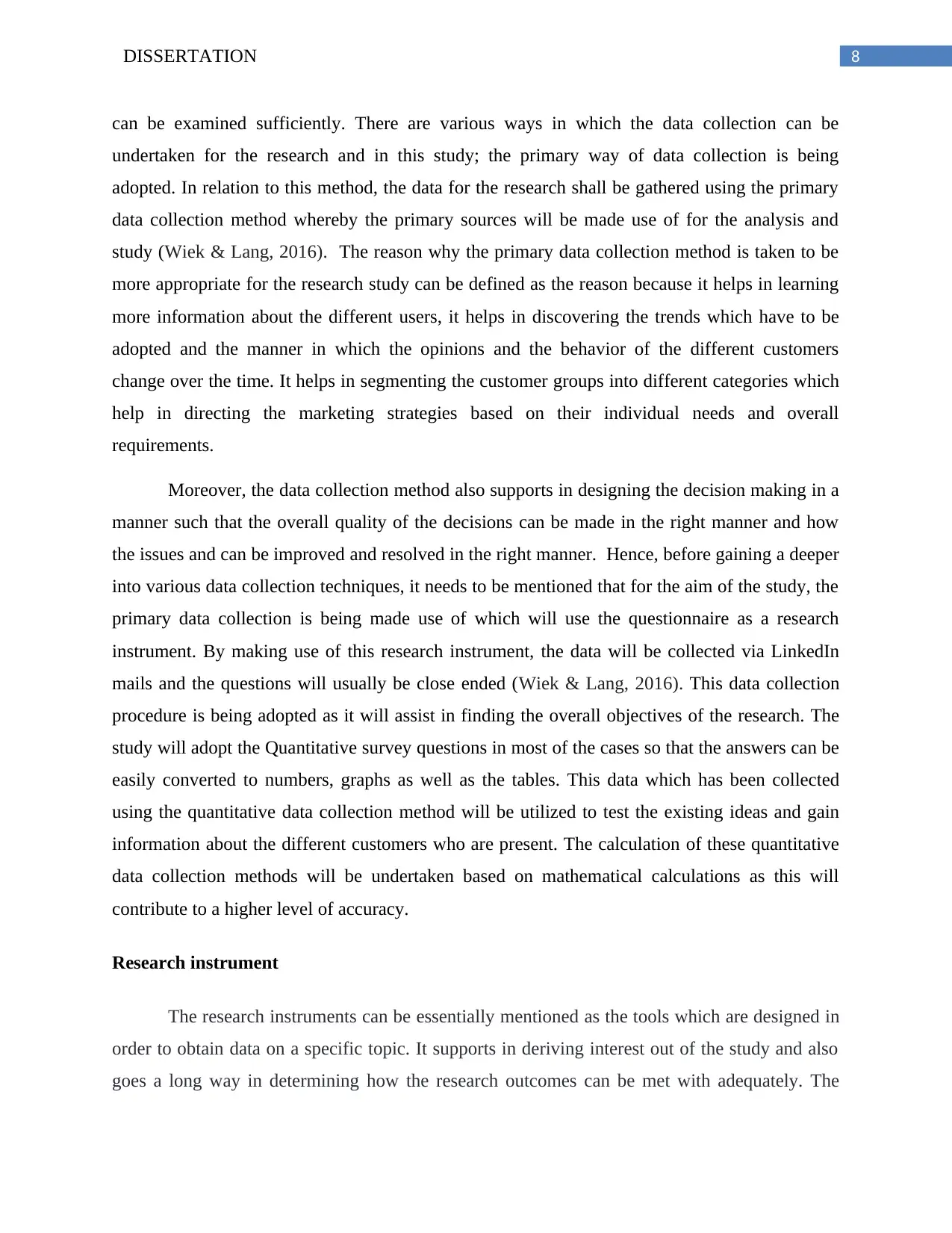
8DISSERTATION
can be examined sufficiently. There are various ways in which the data collection can be
undertaken for the research and in this study; the primary way of data collection is being
adopted. In relation to this method, the data for the research shall be gathered using the primary
data collection method whereby the primary sources will be made use of for the analysis and
study (Wiek & Lang, 2016). The reason why the primary data collection method is taken to be
more appropriate for the research study can be defined as the reason because it helps in learning
more information about the different users, it helps in discovering the trends which have to be
adopted and the manner in which the opinions and the behavior of the different customers
change over the time. It helps in segmenting the customer groups into different categories which
help in directing the marketing strategies based on their individual needs and overall
requirements.
Moreover, the data collection method also supports in designing the decision making in a
manner such that the overall quality of the decisions can be made in the right manner and how
the issues and can be improved and resolved in the right manner. Hence, before gaining a deeper
into various data collection techniques, it needs to be mentioned that for the aim of the study, the
primary data collection is being made use of which will use the questionnaire as a research
instrument. By making use of this research instrument, the data will be collected via LinkedIn
mails and the questions will usually be close ended (Wiek & Lang, 2016). This data collection
procedure is being adopted as it will assist in finding the overall objectives of the research. The
study will adopt the Quantitative survey questions in most of the cases so that the answers can be
easily converted to numbers, graphs as well as the tables. This data which has been collected
using the quantitative data collection method will be utilized to test the existing ideas and gain
information about the different customers who are present. The calculation of these quantitative
data collection methods will be undertaken based on mathematical calculations as this will
contribute to a higher level of accuracy.
Research instrument
The research instruments can be essentially mentioned as the tools which are designed in
order to obtain data on a specific topic. It supports in deriving interest out of the study and also
goes a long way in determining how the research outcomes can be met with adequately. The
can be examined sufficiently. There are various ways in which the data collection can be
undertaken for the research and in this study; the primary way of data collection is being
adopted. In relation to this method, the data for the research shall be gathered using the primary
data collection method whereby the primary sources will be made use of for the analysis and
study (Wiek & Lang, 2016). The reason why the primary data collection method is taken to be
more appropriate for the research study can be defined as the reason because it helps in learning
more information about the different users, it helps in discovering the trends which have to be
adopted and the manner in which the opinions and the behavior of the different customers
change over the time. It helps in segmenting the customer groups into different categories which
help in directing the marketing strategies based on their individual needs and overall
requirements.
Moreover, the data collection method also supports in designing the decision making in a
manner such that the overall quality of the decisions can be made in the right manner and how
the issues and can be improved and resolved in the right manner. Hence, before gaining a deeper
into various data collection techniques, it needs to be mentioned that for the aim of the study, the
primary data collection is being made use of which will use the questionnaire as a research
instrument. By making use of this research instrument, the data will be collected via LinkedIn
mails and the questions will usually be close ended (Wiek & Lang, 2016). This data collection
procedure is being adopted as it will assist in finding the overall objectives of the research. The
study will adopt the Quantitative survey questions in most of the cases so that the answers can be
easily converted to numbers, graphs as well as the tables. This data which has been collected
using the quantitative data collection method will be utilized to test the existing ideas and gain
information about the different customers who are present. The calculation of these quantitative
data collection methods will be undertaken based on mathematical calculations as this will
contribute to a higher level of accuracy.
Research instrument
The research instruments can be essentially mentioned as the tools which are designed in
order to obtain data on a specific topic. It supports in deriving interest out of the study and also
goes a long way in determining how the research outcomes can be met with adequately. The
⊘ This is a preview!⊘
Do you want full access?
Subscribe today to unlock all pages.

Trusted by 1+ million students worldwide

9DISSERTATION
research instruments are also used to collect the data will also be made use of to keep a record of
the data which is to be collected for the research (Wiek & Lang, 2016). The research sample
which is being made use of in the given paper can be described as the questionnaire. The
questionnaire will follow the quantitative design whereby it will aim to ask the different
respondents certain closed ended questions and this will then assist in finding the results to the
study.
Additionally, the questionnaire will also help in presenting the adequate information of
the study which will then assist in deriving the graphical presentation of the data by making use
of various graphs as well as charts. In this research, the use of the questionnaire is being made to
collect the data from the various sources and additionally to graphically represent the
information which is available.
Data analysis procedure
The data analysis can be described as the manner in which the quantitative studies is
usually gathered and generally tends to involve a critical analysis of the interpretation of the
figures and the numbers which helps in finding the manner in which the findings of the study can
be presented (Quinlan et al., 2019). This analysis procedure also supports in comparing the
primary research findings to the overall findings of the review of literature. The method of data
analysis supports in certifying that the common patterns can be undertaken in a sound manner
and that the different controversies can be avoided. It helps in decision making regarding the
study and the data analysis methods which are usually present around the primary data collection
techniques involve the discussion of the common patterns and assist in finding the answer to the
research problems which tends to exist (Ramirez et al., 2015). Hence, in relation to this, the
major manners in which the data has to be analyzed for the research can be contributed to be the
Statistical analysis method (Silverman, 2016). In this kind of an analysis method, the past data is
made use of in order to undertake an analysis about the future. In this type of an analysis
technique or method, the data is usually collected and analyzed with the help of either descriptive
analysis or the inferential analysis (Sutrisna & Setiawan, 2016). This then contributes towards
comprehending the manner in which outcomes of the study which has been planned initially can
be identified.
research instruments are also used to collect the data will also be made use of to keep a record of
the data which is to be collected for the research (Wiek & Lang, 2016). The research sample
which is being made use of in the given paper can be described as the questionnaire. The
questionnaire will follow the quantitative design whereby it will aim to ask the different
respondents certain closed ended questions and this will then assist in finding the results to the
study.
Additionally, the questionnaire will also help in presenting the adequate information of
the study which will then assist in deriving the graphical presentation of the data by making use
of various graphs as well as charts. In this research, the use of the questionnaire is being made to
collect the data from the various sources and additionally to graphically represent the
information which is available.
Data analysis procedure
The data analysis can be described as the manner in which the quantitative studies is
usually gathered and generally tends to involve a critical analysis of the interpretation of the
figures and the numbers which helps in finding the manner in which the findings of the study can
be presented (Quinlan et al., 2019). This analysis procedure also supports in comparing the
primary research findings to the overall findings of the review of literature. The method of data
analysis supports in certifying that the common patterns can be undertaken in a sound manner
and that the different controversies can be avoided. It helps in decision making regarding the
study and the data analysis methods which are usually present around the primary data collection
techniques involve the discussion of the common patterns and assist in finding the answer to the
research problems which tends to exist (Ramirez et al., 2015). Hence, in relation to this, the
major manners in which the data has to be analyzed for the research can be contributed to be the
Statistical analysis method (Silverman, 2016). In this kind of an analysis method, the past data is
made use of in order to undertake an analysis about the future. In this type of an analysis
technique or method, the data is usually collected and analyzed with the help of either descriptive
analysis or the inferential analysis (Sutrisna & Setiawan, 2016). This then contributes towards
comprehending the manner in which outcomes of the study which has been planned initially can
be identified.
Paraphrase This Document
Need a fresh take? Get an instant paraphrase of this document with our AI Paraphraser

10DISSERTATION
The statistical analysis usually comprises of the descriptive analysis which comprises of
the data or a sample summarized of numerical data and reflects the mean as well as the deviation
for the continuous data whereas the percentage and the frequency for the categorical data are
identified (McCusker & Gunaydin, 2015). Additionally, the inferential analysis can be
undertaken in order to derive certain conclusions from the same data but by making use of
different samples. Therefore, as the study aims to find the appropriate marketing techniques for
the generation of lead, it is integral that the study makes use of the statistical quantitative data
analysis technique whereby the statistical tools will be made use of (Ørngreen & Levinsen,
2017). The SPSS software will be essentially used to arrive at the research findings and the
reverence to this, the outcomes of the study will be essentially achieved. Through the SPSS
software, the study will aim to find the manner in which the right kind of marketing strategy can
be adopted for the research (Pruzan, 2016).
Research Budget
The research budget can be essential described as the overall investment which is generally
involved in the research study (Mackey & Gass, 2015). The research budget is the sum total of
all the expenses which are essentially incurred in by the researcher in order to carry out the
research in a comprehensive manner and in order to determine the ways in which the research
objectives can be essentially attained. The research will be involving the following costs:
1. Data collection: As the survey is being selected as the research instrument, it is essential
that the survey is distributed and it is this aspect which will be enquiring certain
investment (Lushey & Munro, 2015). This is because, without the essential investment,
the outcomes of the study cannot be achieved efficaciously.
2. Data analysis: The data will be analyzed by making use of the SPSS as a software and it
is in relating to this that the software will be required to be purchased and this will
thereby incur additional costs with respect to which the researcher would be required to
bear these costs (Liamputtong, 2016).
3. Additionally, for the review of literature, various journal articles would be analyzed
which have to be essentially collected with the help of subscription of various databases.
The statistical analysis usually comprises of the descriptive analysis which comprises of
the data or a sample summarized of numerical data and reflects the mean as well as the deviation
for the continuous data whereas the percentage and the frequency for the categorical data are
identified (McCusker & Gunaydin, 2015). Additionally, the inferential analysis can be
undertaken in order to derive certain conclusions from the same data but by making use of
different samples. Therefore, as the study aims to find the appropriate marketing techniques for
the generation of lead, it is integral that the study makes use of the statistical quantitative data
analysis technique whereby the statistical tools will be made use of (Ørngreen & Levinsen,
2017). The SPSS software will be essentially used to arrive at the research findings and the
reverence to this, the outcomes of the study will be essentially achieved. Through the SPSS
software, the study will aim to find the manner in which the right kind of marketing strategy can
be adopted for the research (Pruzan, 2016).
Research Budget
The research budget can be essential described as the overall investment which is generally
involved in the research study (Mackey & Gass, 2015). The research budget is the sum total of
all the expenses which are essentially incurred in by the researcher in order to carry out the
research in a comprehensive manner and in order to determine the ways in which the research
objectives can be essentially attained. The research will be involving the following costs:
1. Data collection: As the survey is being selected as the research instrument, it is essential
that the survey is distributed and it is this aspect which will be enquiring certain
investment (Lushey & Munro, 2015). This is because, without the essential investment,
the outcomes of the study cannot be achieved efficaciously.
2. Data analysis: The data will be analyzed by making use of the SPSS as a software and it
is in relating to this that the software will be required to be purchased and this will
thereby incur additional costs with respect to which the researcher would be required to
bear these costs (Liamputtong, 2016).
3. Additionally, for the review of literature, various journal articles would be analyzed
which have to be essentially collected with the help of subscription of various databases.

11DISSERTATION
These databases will be subscribed t and the objectives of the research will be attained
accordingly.
3.4 Ethical considerations
The ethical considerations can be referred to as the ethical issues which are generally
faced by the organization regarding the study which is undertaken (Ledford & Gast, 2018).
With respect to this, the ethical issues which are usually faced by the research tend to relate
to that of the maintenance of the privacy of the different participants in the research.
Additionally, the ethical aspects which are required to be considered can also be mentioned
regarding the plagiarism and other such problems (Kumar, 2019). Therefore, with reverence
to this, the researcher would be required to follow all the ethical criteria’s pertaining to the
human research ethics committee as this would help in certifying that the research can be
carried out in an effective manner and thereby the research needs to be following all the
guidelines relating to the ANU Human research ethics Committee (HREC) (Humphries,
2017). The information which the different individuals provide in the survey needs to be
protected and the privacy needs to be maintained. Additionally, the study protocol is required
to be submitted in a manner such that the research is carried out in a manner such that the
requirements are maintained.
3.5 Conclusion
Hence, from the research aspects which are generally undertaken, it becomes critical to
see to it that, the research methodology indeed forms one of the most critical aspects of the
research with the help of which the research paper is required to be carried out critically.
Therefore, the study was based on the discussion of the different research techniques and
tools which were utilized for the aim of the research. The different aspects like the research
approach, philosophy, strategy and other design aspects along with data collection and data
analysis will be adopted.
These databases will be subscribed t and the objectives of the research will be attained
accordingly.
3.4 Ethical considerations
The ethical considerations can be referred to as the ethical issues which are generally
faced by the organization regarding the study which is undertaken (Ledford & Gast, 2018).
With respect to this, the ethical issues which are usually faced by the research tend to relate
to that of the maintenance of the privacy of the different participants in the research.
Additionally, the ethical aspects which are required to be considered can also be mentioned
regarding the plagiarism and other such problems (Kumar, 2019). Therefore, with reverence
to this, the researcher would be required to follow all the ethical criteria’s pertaining to the
human research ethics committee as this would help in certifying that the research can be
carried out in an effective manner and thereby the research needs to be following all the
guidelines relating to the ANU Human research ethics Committee (HREC) (Humphries,
2017). The information which the different individuals provide in the survey needs to be
protected and the privacy needs to be maintained. Additionally, the study protocol is required
to be submitted in a manner such that the research is carried out in a manner such that the
requirements are maintained.
3.5 Conclusion
Hence, from the research aspects which are generally undertaken, it becomes critical to
see to it that, the research methodology indeed forms one of the most critical aspects of the
research with the help of which the research paper is required to be carried out critically.
Therefore, the study was based on the discussion of the different research techniques and
tools which were utilized for the aim of the research. The different aspects like the research
approach, philosophy, strategy and other design aspects along with data collection and data
analysis will be adopted.
⊘ This is a preview!⊘
Do you want full access?
Subscribe today to unlock all pages.

Trusted by 1+ million students worldwide
1 out of 52
Related Documents
Your All-in-One AI-Powered Toolkit for Academic Success.
+13062052269
info@desklib.com
Available 24*7 on WhatsApp / Email
![[object Object]](/_next/static/media/star-bottom.7253800d.svg)
Unlock your academic potential
Copyright © 2020–2025 A2Z Services. All Rights Reserved. Developed and managed by ZUCOL.





